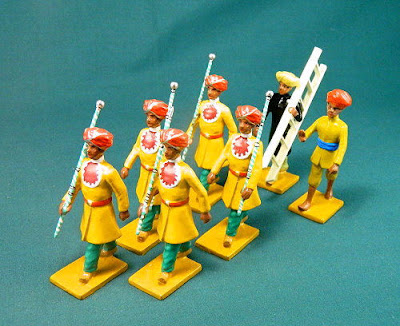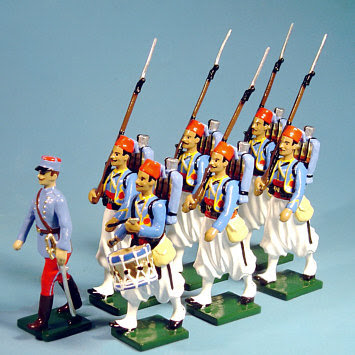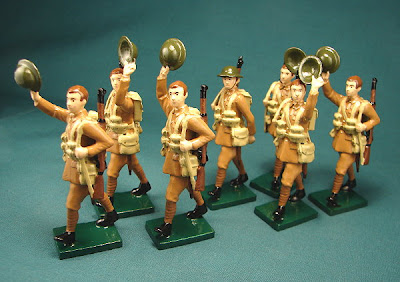In this the last of my LA posts for this year I have decided to include a little historical background on the unit that inspired the figures alongside a few images of the pieces themselves
The figures represent soldiers from the Waffen SS Division Florian Geyer and the complete set is made up of four troopers and two officers. The first picture shows the figure I bought at the BTSS in October
History
The 8th SS Cavalry Division Florian Geyer was a Waffen SS cavalry formation during World War II. It was formed in 1942 from a cadre of the SS Cavalry Brigade which was involved in anti partisan operations behind the front line and was responsible for the extermination of tens of thousands of civilians on the Eastern Front. About 40% of the division were Volksdeutsche from Siebenbürgen (Transylvania) and Banat (Serbia)
| One of the two officer figures depicted as part of the set |
The Training and Replacement Battalion of the 8th SS Cavalry Division was involved in suppressing the 1943 Warsaw Ghetto Uprising. In March 1944, it was named after Florian Geyer (1490–1525), the Franconian nobleman who led the Black Company during the Peasants War, and was destroyed during the fighting in Budapest in early 1945
| A regular trooper with an assault rifle slung over his back |
| He looks a little lop-sided if I'm honest, but with careful positioning in a diorama this drawback can be very easily remedied |
Soon after its formation it was sent to fight in the Rzhev and Orel sectors in central Russia where it stayed until the spring of 1943. The division was then moved to the area around Bobruisk, on internal security and anti partisan duties until September 1943. In September the division was moved to the Southern front and took part in the German retreat to the Dnieper river
| The business end of his weapon could do with a bit of attention too! |
The division was then sent to Hungary in October 1943, where the Panzerjager and Sturmgeschütz Battalions were combined and the Reconnaissance Battalion became a Panzer Reconnaissance Battalion. Following this reorganization the division was posted to Croatia. In April 1944, they returned to Hungary and took part in the fighting in Transylvania after the Romanian front collapsed
| The second of the two officer figures, complete with mp40 and new orders in hand |
| A little more corrective paintwork needed on this figure also, to hide the glue line around the equipment bag and to cover a few hairline cracks on the bottoms of the horse's legs |
The division was trapped in Budapest with the IX SS Mountain Corps when the Russians surrounded the city in December 1944. The 8th SS Cavalry Division was then involved in the fierce fighting to hold the city and was often engaged in hand to hand combat and fighting house to house. The Division was destroyed in the fighting for Budapest
Commanders
• SS-Brigadeführer Gustav Lombard, (March 1942 - April 1942)
• SS-Gruppenführer Hermann Fegelein, (April 1942 - August 1942)
• SS-Obergruppenführer Wilhelm Bittrich, (August 1942 - 15 February 1943)
• SS-Brigadeführer Fritz Freitag, (15 February 1943 - 20 April 1943)
• SS-Brigadeführer Gustav Lombard, (20 April 1943 - 14 May 1943)
• SS-Gruppenführer Hermann Fegelein, (14 May 1943 - 13 September 1943)
• SS-Gruppenführer Bruno Streckenbach, (13 September 1943 - 22 October 1943)
• SS-Gruppenführer Hermann Fegelein, (22 October 1943 - 1 January 1944)
• SS-Gruppenführer Bruno Streckenbach, (1 January 1944 - 14 April 1944)
• SS-Brigadeführer Gustav Lombard, (14 April 1944 - 1 July 1944)
• SS-Brigadeführer Joachim Rumohr, (1 July 1944 - 11 Feb 1945)
• SS-Gruppenführer Hermann Fegelein, (April 1942 - August 1942)
• SS-Obergruppenführer Wilhelm Bittrich, (August 1942 - 15 February 1943)
• SS-Brigadeführer Fritz Freitag, (15 February 1943 - 20 April 1943)
• SS-Brigadeführer Gustav Lombard, (20 April 1943 - 14 May 1943)
• SS-Gruppenführer Hermann Fegelein, (14 May 1943 - 13 September 1943)
• SS-Gruppenführer Bruno Streckenbach, (13 September 1943 - 22 October 1943)
• SS-Gruppenführer Hermann Fegelein, (22 October 1943 - 1 January 1944)
• SS-Gruppenführer Bruno Streckenbach, (1 January 1944 - 14 April 1944)
• SS-Brigadeführer Gustav Lombard, (14 April 1944 - 1 July 1944)
• SS-Brigadeführer Joachim Rumohr, (1 July 1944 - 11 Feb 1945)
 |
| Divisional Crest |
Straight out of the box, leaving aside the odd bit of touching up here and there, these figures are very pleasing, and certainly well worth the £55 per figure price tag. They're weighty pieces, adequately painted for the money and very well posed. My personal favourite is this one, showing one of the regular troopers reaching out to give his steed a well deserved pat of reassurance, or thanks, and demonstrating the important bond that exists between man and animal in such trying times
Happy New Year, happy hunting, and happy collecting! See you again in 2012!





































